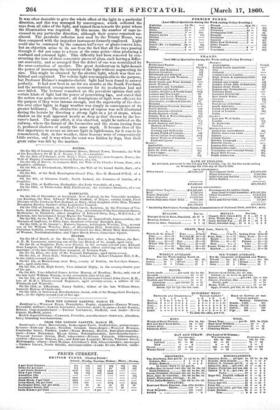ROYAL INSTITUTION.
On fhe 9th instant, Professor Faraday delivered an interesting lecture on "On Lighthouses," and their illumination by means of the electric light. The simple idea of a lighthouse was exemplified by the candle placed in the cottage window to guide the labourer back to his dwelling.
It was often desirable to give the whole effect of the light in a particular direction, and this was managed by convergence, which collected the rays from all sides of the light, and turned them towards the point where the illumination was required. By this means, the number of rays in- creased in any particular direction, although their source remained un- altered. The parabolic reflector now used by the Trinity House, was then compared with the imperfect instrument formerly employed. Light could also be conveyed by the common bull's-eye or plano-convex lens, but an objection arose to its use from the fact that all the rays passing through it did not come to a focus at the same point—thus producing a confused and coloured light. This difficulty had been removed by con- structing the lens of three concentric pieces of glass, each having a differ- ent convexity, and so arranged that the defect of one was neutralized by the over-correction of another. The great desideratum in light-houses the power of increasing the intensity of the light without augmenting its size. This might be obtained by the electric light, which was then ex- hibited and explained. The voltaic light was inapplicable to the purpose, but Professor Holmes's magneto-electric light had been found to answer perfectly. It had now been in use for six months at the South Foreland, and the mechanical arrangements necessary for its production had not once failed. The lecturer remarked on the prevalent opinion that only certain kinds of light had the power of penetrating fogs, and stated that the notion was quite incorrect ; all descriptions of light were efficient for the purpose if they were intense enough, and the superiority of the elec- tric over other lights in foggy weather was simply in consequence of its greater brilliancy. The obstructive power of vapour was well illustrated during the lecture by directing a strong light on a jet of steam, whose shadow on the wall appeared nearly as deep as that thrown by the lec- turer's hand. The same effect, it was observed, might be noticed on the railway, where the funnel of the locomotive and the steam issuing from it, produced shadows of nearly the same depth. It became then of the first importance to secure an intense light in lighthouses, for it was to be remembered, that, in fine weather, these beacons were of' comparatively little service, and it was when the coast was hidden by fogs, that their great value was felt by the mariner.



























 Previous page
Previous page